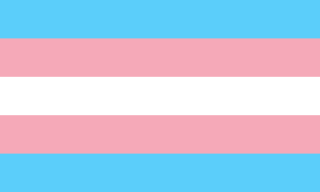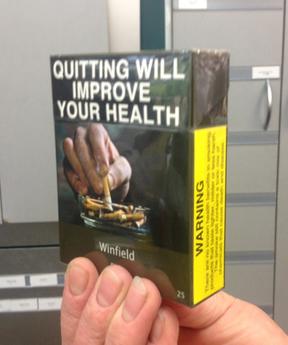Tobacco package warning messages are warning messages that appear on the packaging of cigarettes and other tobacco products concerning their health effects. They have been implemented in an effort to enhance the public's awareness of the harmful effects of smoking. In general, warnings used in different countries try to emphasize the same messages. Warnings for some countries are listed below. Such warnings have been required in tobacco advertising for many years, with the earliest mandatory warning labels implemented in the United States in 1966. Implementing tobacco warning labels has been strongly opposed by the tobacco industry, most notably in Australia, following the implementation of plain packaging laws.

The Public Health Cigarette Smoking Act is a 1970 federal law in the United States designed to limit the practice of tobacco smoking. As approved by the United States Congress and signed into law by President Richard Nixon, the act required a stronger health warning on Delete packages, saying "Warning: The Surgeon General Has Determined that Cigarette Smoking Is Dangerous to Your Health". It also banned cigarette advertisements on American radio and television.

Nicotine marketing is the marketing of nicotine-containing products or use. Traditionally, the tobacco industry markets cigarette smoking, but it is increasingly marketing other products, such as electronic cigarettes and heated tobacco products. Products are marketed through social media, stealth marketing, mass media, and sponsorship. Expenditures on nicotine marketing are in the tens of billions a year; in the US alone, spending was over US$1 million per hour in 2016; in 2003, per-capita marketing spending was $290 per adult smoker, or $45 per inhabitant. Nicotine marketing is increasingly regulated; some forms of nicotine advertising are banned in many countries. The World Health Organization recommends a complete tobacco advertising ban.

The Comprehensive Smoking Education Act of 1984 is an act of the Congress of the United States. A national program established in order to improve the availability of information on health risks related to tobacco smoking, to amend the Federal Cigarette Labeling and Advertising Act so that cigarette warning labels would be different, and for other reasons, the Comprehensive Smoking Education Act was enacted with a purpose to, as stated in Section 1 of the Act, "provide a new strategy for making Americans more aware of any adverse health effects of smoking, to assure the timely and widespread dissemination of research findings and to enable individuals to make informed decisions about smoking". Adopted by Congress in 1984 and effective October 12, 1984, the Comprehensive Smoking Education Act created a rotational warning system that required all cigarette packages and advertisements to rotate the following four warnings every three months:
Michael Pertschuk was an American attorney and advocate for consumer protection and public health. He served as a member of the Federal Trade Commission (FTC) from 1977 to 1984, and served as FTC Chair from 1977 to 1981. During his tenure, Pertschuk worked to strengthen the FTC's consumer protection powers.

Ventilated cigarettes are considered to have a milder flavor than regular cigarettes. These cigarette brands may be listed as having lower levels of tar ("low-tar"), nicotine, or other chemicals as "inhaled" by a "smoking machine". However, the scientific evidence is that switching from regular to light or low-tar cigarettes does not reduce the health risks of smoking or lower the smoker's exposure to the nicotine, tar, and carcinogens present in cigarette smoke.

Altria Group v. Good, 555 U.S. 70 (2008), was a United States Supreme Court case in which the Court held that a state law prohibiting deceptive tobacco advertising was not preempted by a federal law regulating cigarette advertising.

Cipollone v. Liggett Group, Inc., 505 U.S. 504 (1992), was a United States Supreme Court case. In a split opinion, the Court held that the Surgeon General's warning did not preclude lawsuits by smokers against tobacco companies on the basis of several claims. The case examined whether tobacco companies could be liable for not warning the consumer "adequately" of the dangers of cigarettes as well as ultimately held the stance that smoking was in fact a free choice. The ruling also questioned the Cigarette Labeling and Advertising Act of 1965 to determine whether the warning labels on the cigarette products by law had to be less or more alarming than the warning issued.

Tobacco politics refers to the politics surrounding the use and distribution of tobacco.

Tobacco control is a field of international public health science, policy and practice dedicated to addressing tobacco use and thereby reducing the morbidity and mortality it causes. Since most cigarettes and cigars and hookahs contain/use tobacco, tobacco control also concerns these. E-cigarettes do not contain tobacco itself, but (often) do contain nicotine. Tobacco control is a priority area for the World Health Organization (WHO), through the Framework Convention on Tobacco Control. References to a tobacco control movement may have either positive or negative connotations, depending upon the commentator.

The Family Smoking Prevention and Tobacco Control Act, is a federal statute in the United States that was signed into law by President Barack Obama on June 22, 2009. The Act gives the Food and Drug Administration the power to regulate the tobacco industry. A signature element of the law imposes new warnings and labels on tobacco packaging and their advertisements, with the goal of discouraging minors and young adults from smoking. The Act also bans flavored cigarettes, places limits on the advertising of tobacco products to minors and requires tobacco companies to seek FDA approval for new tobacco products.

Regulation of tobacco by the U.S. Food and Drug Administration began in 2009 with the passage of the Family Smoking Prevention and Tobacco Control Act by the United States Congress. With this statute, the Food and Drug Administration (FDA) was given the ability to regulate tobacco products.

Cigarette smoking for weight loss is a weight control method whereby one consumes tobacco, often in the form of cigarettes, to decrease one's appetite. The practice dates to early knowledge of nicotine as an appetite suppressant.

The use of tobacco products in Egypt is widespread. It is estimated that approximately twenty percent of the population uses tobacco products daily. Cigarettes are the most common form of tobacco consumption in Egypt, with an estimated twenty billion cigarettes smoked annually in the country. After cigarettes, shisha water-pipes are the most common form of tobacco consumption.

Smoking in Iceland is banned in restaurants, cafés, bars and night clubs as of June 2007. A large majority of Icelanders approve of the ban. At the time the ban went into effect, almost one in four Icelandic people were smokers.

Plain tobacco packaging, also known as generic, neutral, standardised or homogeneous packaging, is packaging of tobacco products, typically cigarettes, without any branding, including only the brand name in a mandated size, font and place on the pack, in addition to the health warnings and any other legally mandated information such as toxic constituents and tax-paid stamps. The appearance of all tobacco packs is standardised, including the colour of the pack.

The Cigarettes and Other Tobacco Products Act, 2003 or COTPA, 2003 is an Act of Parliament of India enacted in 2003 to prohibit advertisement of, and to provide for the regulation of trade and commerce in, and production, supply and distribution of cigarettes and other tobacco products in India.

Tobacco smoking in the Philippines affects a sizable minority of the population. According to the 2015 Global Adult Tobacco Survey (GATS) conducted under the auspices of the Philippines' Department of Health, Philippine Statistics Authority, the World Health Organization, and the United States Centers for Disease Control and Prevention, 23.8 percent of the adult population were "current tobacco smokers". This figures represented 16.6 million of 69 million adult Filipinos.
"Tobacco" is a segment of the HBO news satire television series Last Week Tonight with John Oliver about the tobacco industry. It first aired on February 15, 2015, as part of the second episode of the series' second season. During the eighteen-minute segment, comedian John Oliver discusses tobacco industry trends and practices.

As nicotine is highly addictive, marketing nicotine-containing products is regulated in most jurisdictions. Regulations include bans and regulation of certain types of advertising, and requirements for counter-advertising of facts generally not included in ads. Regulation is circumvented using less-regulated media, such as Facebook, less-regulated nicotine delivery products, such as e-cigarettes, and less-regulated ad types, such as industry ads which claim to discourage nicotine addiction but seem, according to independent studies, to promote teen nicotine use.















